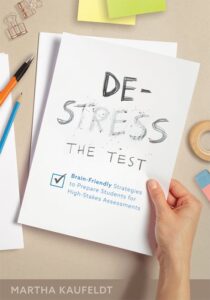Brain-Friendly Tools to De-Stress the Test
De-Stress the Test: Brain-Friendly Strategies to Prepare Students for High Stakes Assessments
By Martha Kaufeldt
(Solution Tree Press, 2022 – Learn more)
Reviewed by Stephanie Choate

While this has a very positive impact on test results, Martha Kaufeldt explores tools that can be used at any level and can improve the overall environment of your classroom.
I am not involved in high stakes testing as much as my public school colleagues are, but I do teach both AP Language and Composition as well as AP Literature and Composition. For years I avoided these classes because I felt the extra pressure that comes with spending a year preparing students for a multi-hour exam that they could fail after a year of hard work.

Many of us in education, whether we teach higher level classes or not, are definitely aware our students are stressed. We see them worry over grades, complete hours of homework, hold jobs, and attend grueling practices every day.
Saying that large tests, and school in general, are stress inducing is common sense, but understanding the why at a biological and psychological level is very helpful. Martha Kaufeldt digs deep into the brain’s response to different situations in the classroom, showing that students’ stress is a natural response to their environment, but there are ways we can reduce stress in our classrooms.
The Breakdown of De-Stressing the Test
Part 1 discusses the history of standardized testing and the negative impacts stress has on the mind and body, which has resulted in what Kaufeldt coined “the testing-stress mess.” It is clear the author, and those that she cites throughout the book, find that education’s testing culture negatively impacts students. However, she acknowledges that “tests are here to stay,” so we need to find ways to better prepare our students for them, and this goes beyond content.
Part 2 is about stress prevention strategies. Kaufeldt offers ideas to make your classroom a place where students feel safe, both physically and mentally. Kaufeldt lists the basic stress triggers as “physical environment, schedules, chaos and confusion, basic needs, social-emotional culture, and challenging academics” and offers strategies for each that ultimately allow students to be comfortable in their learning environments. Mindfulness practices, growth mindsets, and creating student agency take center stage as ways to help students decrease their stress levels.
It is important to note here that there are certain levels of stress that are good. The term for healthy stress is eustress, which keeps us “engaged, motivated, and excited.” The opposite, and more well-known term, is distress. Kaufeldt includes Vygotsky’s “Zone of Proximal Development” among other examples to show that we do need to push students to challenge themselves but in a way that shows it is okay to make mistakes, especially in the classroom.
Formative assessments and class activities are the perfect time to make the mistakes, but there is so much stress and fear surrounding being “wrong.” Students need an environment that shows them it’s okay. When students feel better able to tackle a challenge, this mentality allows them to learn more successfully and perform better on high-stakes tests.
Part 2’s stress prevention strategies coupled with Part 3’s tips on how to prepare students for tests in ways that are more content and pedagogy focused allow a teacher to create the balance needed to teach their students and prepare for testing without inadvertently causing more stress.
Part 3 is what I thought most of the book would focus on, but I think the strategies were more helpful with a better understanding of why they work. In this section, Kaufeldt includes information on frequent feedback that “feeds forward” and doesn’t focus solely on past tasks. We know that feedback needs to be immediate, meaningful, and constructive, but that can often be difficult with hundreds of students and assignments. Therefore, she offers tips for how to check in quickly with students to gauge their understanding.
The last chapter includes over a dozen test taking strategies that include everything from study skills to eating a good breakfast on test day. If you are solely looking for strategies for test taking, part 3 of this book is what you want to focus on, but the most important takeaway from the book is that de-stressing the test starts far before the test itself. It starts on the first day with the environment you create in your classroom and the expectations you set for your students.
Are tests here to stay?
In the Epilogue, Kaufeldt includes information about how a lot of high-stakes tests were canceled during the Covid pandemic. Many universities have decided to remain test optional since. So the real question is, are changes on the way? Whether they are or not, the majority of this book is still useful to educators. School is a naturally stress inducing place for many students, so working to alleviate those feelings will only make our classrooms happier and more productive places.
Stephanie Choate is the English Department Chair and a teacher at Austin Preparatory School in Massachusetts. A lover of Shakespeare, rhetoric, and young adult literature, Stephanie facilitates workshops with the PD Collab, has presented at a Keeping the Wonder workshop, and is also a trained executive function tutor. You can find her work and book recommendations on her Instagram @scarvesandseminars.






























